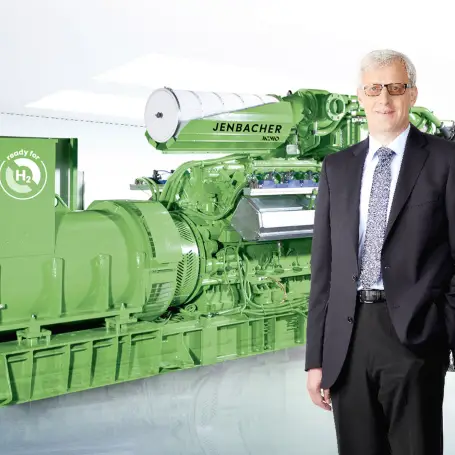Stephan Laiminger, chief technologist at INNIO Jenbacher, discusses why hydrogen – both blue and green in color – will play a significant role in the future of power generation.

With CO2 emissions still rising, global warming will continue if the planet does not decrease its reliance on fossil fuels. The switch from fossil fuels to renewable fuels in power generation clearly is a step in the right direction, but Europe cannot currently cover its energy demand with renewable energy alone. So, what are the available alternatives?
So, what are the available alternatives?
Stephan Laiminger, chief technologist at INNIO Jenbacher, investigates future green technology trends for his company. It’s a company, he says, that specifically focuses on how it can help shape a low-carbon economy.
INNIO is a shaper of the energy transition. Already today, more than half of our installed fleet in Europe is operating on carbon-neutral fuels such as biogas, wood gas or biomethane. The question we ask ourselves is ‘what's next?’ How can we make power generation carbon-free?
Stephan Laiminger, Chief Technologist at INNIO Jenbacher

There are two possibilities:
First, to slow global warming
We must switch away from fossil fuels and move to alternative fuels such as hydrogen. For generation from surplus green power, hydrogen is produced by splitting water into hydrogen and oxygen via electrolysis. Hydrogen then can be stored directly or in the form of hydrogen carriers, such as ammonia, methanol or liquid organic hydrogen carriers. In this way, electricity can be stored for weeks or even months.
This will help to get the fluctuations in the renewable energy system under control and enables green energy generation during the dark and cold winter months, when wind and sun are not available, also for us, blue hydrogen can accelerate the build-up of a green hydrogen infrastructure. We cannot simply switch from one day to the other. We need a ramp-up phase to make the infrastructure hydrogen ready.
Stephan Laiminger, Chief Technologist at INNIO Jenbacher
The other process is to remove
carbon from fossil fuels and store
the carbon, so it's not released into
the atmosphere.
In this process, we discuss the ‘colors’ of hydrogen, with ‘blue’ hydrogen, we remove the carbon out of the natural gas and use the remaining hydrogen to operate the engine. If executed properly, CO2 can be stored and is not released into the atmosphere.
Those two methods are a way forward to counter global warming. For the engine, it doesn’t matter if the hydrogen is ‘blue’ or ‘green’ – it’s simply the energy carrier. But for the global economy, we must find the most cost-effective solution. Because, if a process is prohibitively costly, it will not be embraced.

Ready for a change
With INNIO’s green technology, customers can reduce their carbon footprint and reach their climate goals. Our engines are highly energy efficient, and we are setting up our products to be ready for a change. If hydrogen is available in large quantities, we will have a product to convert it into heat and power in the most economical way. The primary challenge is that there is not yet enough hydrogen provision to fully move the energy generation onto it. It’s too expensive at this point.
The main advantage offered by green hydrogen is that it does not release CO2 into the atmosphere. It is an excellent energy storage option to transfer surplus renewable energy from summer in the cold and dark winter season. Energy must be stored in large quantities for many weeks, and batteries simply are not large enough. Energy needs to be stored in a chemical form, such as hydrogen. To increase power density for transport over long distances, hydrogen can be carried in the form of ammonia or methanol.
There are scenarios of renewable energy production in large quantities in Saudi Arabia, converted into green hydrogen and ammonia and shipped to Europe. That is a potential way of securing Europe’s green energy supply.
Stephan Laiminger, Chief Technologist at INNIO Jenbacher

Utilizing blue hydrogen now until the green hydrogen infrastructure catches up
To produce green hydrogen requires a lot of electricity. So, there remains a chicken and egg problem in terms of when to make the transition – because the world is switching increasingly toward an electric economy with a growing electricity demand for electric vehicles and electric heating via heat pumps.
The trouble at this point is that not enough surplus green electricity is available to produce green hydrogen. In the longer term, however, green hydrogen will be the right direction. Now, blue hydrogen can help to transfer parts of the fossil fuel industry into the hydrogen industry while also reducing carbon emissions because the carbon is separated upfront.
Blue hydrogen production centralizes the process and uses the hydrogen in the grid to decarbonize the industry. It is also available for other sectors, such as steel production. Also for us, blue hydrogen can accelerate the build-up of a green hydrogen infrastructure. We cannot simply switch from one day to the other. We need a ramp-up phase to make the infrastructure hydrogen ready.
Stephan Laiminger, Chief Technologist at INNIO Jenbacher
So, how long will it take for this transition period of using blue hydrogen before the green infrastructure is ready?
According to Laiminger, governments plan to massively ramp up renewable energy production. On a European level, the initiatives are targeting 2030 for a massive extension of renewable energy and electrolyser availability. Also, to produce blue hydrogen, the infrastructure needs to be ramped up in the forthcoming years. There is a push from governments to switch to non-fossil fuels. As production sites get larger, costs will go down and, finally, there will be a business case for those technologies. We need to ramp it up to a large scale to drive costs down.
Laiminger feels that, fortunately, there is generally an openness in the industry to this change:
We are getting lots of questions from our customers. Specifically, ‘Can our installed power plant be converted?’ Or ’How future-proof or sustainable is our technology?’ Yes, we are set up for the future. What needs to change, though, is the cost of hydrogen. It has to make economical sense. What is clear, is that the industry needs to go in this direction now, to counter global warming. There isn’t a ‘one size fits all’ solution for how to stop climate change. It's not just renewable energy. We also need to store energy over a long period of time – and hydrogen will be a key part of the solution. We have to start now. There is no other option.